Solar System: 10 Things To Know This Week
Solar System: 10 Things to Know This Week
The Living Planet Edition
Whether it’s crops, forests or phytoplankton blooms in the ocean, our scientists are tracking life on Earth. Just as satellites help researchers study the atmosphere, rainfall and other physical characteristics of the planet, the ever-improving view from above allows them to study Earth’s interconnected life.
1. Life on Earth, From Space

While we (NASA) began monitoring life on land in the 1970s with the Landsat satellites, this fall marks 20 years since we’ve continuously observed all the plant life at the surface of both the land and ocean. The above animation captures the entirety of two decades of observations.
2. Watching the World Breathe
With the right tools, we can see Earth breathe. With early weather satellite data in the 1970s and ‘80s, NASA Goddard scientist Compton Tucker was able to see plants’ greening and die-back from space. He developed a way of comparing satellite data in two wavelengths.

When healthy plants are stocked with chlorophyll and ready to photosynthesize to make food (and absorb carbon dioxide), leaves absorb red light but reflect infrared light back into space. By comparing the ratio of red to infrared light, Tucker and his colleagues could quantify vegetation covering the land.
Expanding the study to the rest of the globe, the scientists could track rainy and dry seasons in Africa, see the springtime blooms in North America, and wildfires scorching forests worldwide.
3. Like Breathing? Thank Earth’s Ocean

But land is only part of the story. The ocean is home to 95 percent of Earth’s living space, covering 70 percent of the planet and stretching miles deep. At the base of the ocean’s food web is phytoplankton - tiny plants that also undergo photosynthesis to turn nutrients and carbon dioxide into sugar and oxygen. Phytoplankton not only feed the rest of ocean life, they absorb carbon dioxide - and produce about half the oxygen we breathe.

In the Arctic Ocean, an explosion of phytoplankton indicates change. As seasonal sea ice melts, warming waters and more sunlight will trigger a sudden, massive phytoplankton bloom that feeds birds, sea lions and newly-hatched fish. But with warming atmospheric temperatures, that bloom is now happening several weeks earlier - before the animals are in place to take advantage of it.
4. Keeping an Eye on Crops
The “greenness” measurement that scientists use to measure forests and grasslands can also be used to monitor the health of agricultural fields. By the 1980s, food security analysts were approaching NASA to see how satellite images could help with the Famine Early Warning System to identify regions at risk - a partnership that continues today.

With rainfall estimates, vegetation measurements, as well as the recent addition of soil moisture information, our scientists can help organizations like USAID direct emergency help.
The view from space can also help improve agricultural practices. A winery in California, for example, uses individual pixels of Landsat data to determine when to irrigate and how much water to use.
5. Coming Soon to the International Space Station

A laser-based instrument being developed for the International Space Station will provide a unique 3-D view of Earth’s forests. The instrument, called GEDI, will be the first to systematically probe the depths of the forests from space.

Another ISS instrument in development, ECOSTRESS, will study how effectively plants use water. That knowledge provided on a global scale from space will tell us “which plants are going to live or die in a future world of greater droughts,” said Josh Fisher, a research scientist at NASA’s Jet Propulsion Laboratory and science lead for ECOSTRESS.
6. Seeing Life, From the Microscopic to Multicellular
Scientists have used our vantage from space to study changes in animal habitats, track disease outbreaks, monitor forests and even help discover a new species. Bacteria, plants, land animals, sea creatures and birds reveal a changing world.

Our Black Marble image provides a unique view of human activity. Looking at trends in our lights at night, scientists can study how cities develop over time, how lighting and activity changes during certain seasons and holidays, and even aid emergency responders during power outages caused by natural disasters.
7. Earth as Analog and Proving Ground
Just as our Mars rovers were tested in Earth’s deserts, the search for life on ocean moons in our solar system is being refined by experiments here. JPL research scientist Morgan Cable looks for life on the moons of Jupiter and Saturn. She cites satellite observations of Arctic and Antarctic ice fields that are informing the planning for a future mission to Europa, an icy moon of Jupiter.

The Earth observations help researchers find ways to date the origin of jumbled, chaotic ice. “When we visit Europa, we want to go to very young places, where material from that ocean is being expressed on the surface,” she explained. “Anywhere like that, the chances of finding biomarkers goes up - if they’re there.”
8. Only One Living Planet
Today, we know of only one living planet: our own. The knowledge and tools NASA developed to study life here are among our greatest assets as we begin the search for life beyond Earth.

There are two main questions: With so many places to look, how can we home in on the places most likely to harbor life? What are the unmistakable signs of life - even if it comes in a form we don’t fully understand? In this early phase of the search, “We have to go with the only kind of life we know,” said Tony del Genio, co-lead of a new NASA interdisciplinary initiative to search for life on other worlds.

So, the focus is on liquid water. Even bacteria around deep-sea vents that don’t need sunlight to live need water. That one necessity rules out many planets that are too close or too far from their stars for water to exist, or too far from us to tell. Our Galileo and Cassini missions revealed that some moons of Jupiter and Saturn are not the dead rocks astronomers had assumed, but appear to have some conditions needed for life beneath icy surfaces.
9. Looking for Life Beyond Our Solar System
In the exoplanet (planets outside our solar system that orbit another star) world, it’s possible to calculate the range of distances for any star where orbiting planets could have liquid water. This is called the star’s habitable zone. Astronomers have already located some habitable-zone planets, and research scientist Andrew Rushby of NASA Ames Research Center is researching ways to refine the search. “An alien would spot three planets in our solar system in the habitable zone [Earth, Mars and Venus],” Rushby said, “but we know that 67 percent of those planets are not inhabited.”

He recently developed a model of Earth’s carbon cycle and combined it with other tools to study which planets in habitable zones would be the best targets to look for life, considering probable tectonic activity and water cycles. He found that larger planets are more likely than smaller ones to have surface temperatures conducive to liquid water. Other exoplanet researchers are looking for rocky worlds, and biosignatures, the chemical signs of life.
10. You Can Learn a Lot from a Dot
When humans start collecting direct images of exoplanets, even the closest ones will appear as only a handful of pixels in the detector - something like the famous “blue dot” image of Earth from Saturn. What can we learn about life on these planets from a single dot?

Stephen Kane of the University of California, Riverside, has come up with a way to answer that question by using our EPIC camera on NOAA’s DSCOVR satellite. “I’m taking these glorious pictures and collapsing them down to a single pixel or handful of pixels,” Kane explained. He runs the light through a noise filter that attempts to simulate the interference expected from an exoplanet mission. By observing how the brightness of Earth changes when mostly land is in view compared with mostly water, Kane reverse-engineers Earth’s rotation rate - something that has yet to be measured directly for exoplanets.
The most universal, most profound question about any unknown world is whether it harbors life. The quest to find life beyond Earth is just beginning, but it will be informed by the study of our own living planet.
Make sure to follow us on Tumblr for your regular dose of space: http://nasa.tumblr.com.
More Posts from Matthewjopdyke and Others

You’re looking at a real big deal.
Because in a nanotechnology lab, big deals come in smaller and smaller packages. What you see above is an extreme close-up of a 5 nanometer transistor. In an industry-first, the IBM Research Alliance developed nanosheet transistors that will enable a 5 nm chip. What’s so big about that? Well, by achieving a scale of 30 billion switches on a fingernail sized chip, it can deliver significant enhancements over today’s state-of-the-art 10 nm chips. This not only improves the performance of current technologies but also provides the fuel for the future demands of AI, VR, quantum and mobile technologies to run on. Plus, it could also make things like smartphone batteries last 2-3x longer between charges, so it may also be a real lifesaver too.
Learn more about it->

All three versions (chill, rock, orchestra) Further than Before: Pathway to the Stars, Part 1 -- Audible “Nature and humanity can be amazing, but likewise, it can be brutal. Brutality, as far too many know it, is unnecessary if we consider and implement one thing, innovation with purpose—a good purpose is brutality’s ideal replacement, and it comes minus unnecessary misery. It’s starting to become clear to me now what it is that we can do and how we can do it.” - Eliza Williams to Yesha Alevtina (Further than Before: Pathway to the Stars, Part 1) #books #sciencefictionbooks #SpaceOpera #scifi #ftbpathwaypublications #grahambessellieu #matthewjopdyke #politicalsciencefiction https://www.instagram.com/p/BxGfu74g5Vb/?igshid=16f1jd0ctbwq

Masks are up on store
I am pleased to announce the New Release of Pathway to the Stars: Part 6.1, Trilogy!!! Continue the journey!
In Eliza's preface to her story, she taught us a lot. Here is one of her quotes, available in the new release:
"We need to overcome our apparent fixation toward and acceptance of suffering, misery, and death—many argue to the contrary. We need to rise up and fight against senescence and death, and if necessary, until our own ends. Doing so will fill our lives with purpose and lead to much more than a dismal and silly existence. Life will be a greater reward if we carry on with the spirit or thought of enabling the future of humanity for the long-haul."
~ Eliza Williams - "Pathway to the Stars: Part 6.1, Trilogy," Appendix
Announcing the Second Space Opera Trilogy! Enjoy the journey!
Further Than Before: Pathway to the Stars, Tome
This gigantic manuscript consists of the stories in both “Further Than Before: Pathway to the Stars, Part 1 and Part 2” compiled into a gigantic scholarly text, called the “Tome.” For Eliza and her crew of friends, it is a race against time to meet new cultures, preserve life, and share our legacies with distant civilizations, so we can span the Cosmos and go further than before! Purchase this eBook or HEFT this TOME in the printed format and enjoy the entire original Space Opera! The “Further Than Before” series, subtitled “Pathway to the Stars,” consists of all of the stories in an abridged format, ready for people to see what happens before each of the more detailed “Pathway to the Stars” series booklets are released, and is available in a Part 1 and Part 2, which are in-turn compiled into a gigantic scholarly text, called the “Tome.” Eliza Williams, Yesha Alevtina, James Cooper, Vesha Celeste, Sky Taylor and a host of friendly heroes tackle some of the greatest dilemmas of the day to bring humanity out and into the stars bearing a legacy we would be proud to share with other civilizations–a legacy of kindness, of mind-to-mind communication, of love, and of healing instead of harming. If we are to overcome the great expansion and the death of all life, we must overcome the smaller challenges to progress and focus on even greater ones. Eliza and her team work diligently to speed the pace of society in her world with the belief that beauty and untold potential are within every being. If we find ways to bring that out in ourselves and others, a future where we can breed longevity, a collective and high quality of life, augment the clarity of our minds, and innovate to span the Cosmos may be in our grasp. Within the organization Eliza founded, called Pathway, she and her team takes us on a fantastical and near-Utopian journey to get us out and into the farthest reaches of space, as we advance further than we have before, to make this happen. There are dilemmas such as the need for longevity and the ability to visit loved ones following long journeys, and they put in place the capabilities to overcome the effects of space travel on our physiology and neurology. We journey as Eliza, and her growing crew of friends, are determined to stabilize a rocky economy, wipe away undue suffering, violence, disease, terrorism, and trafficking in persons. They work together to tame seismic activity, weather, and fires. She and her friends tackle ways to prevent extinction and provide solutions to quality of life concerns. They even consider the longevity of our Sun and our Earth’s capacity to preserve life. Eliza tackles each of these issues to get us out, and into the stars, so we can begin our biggest quest–to help our Universe breathe ever so lightly. Allowing it to expand and contract ever so gently, may allow us to preserve its life as well as all of life, allowing us to maximize our mental capacity. With intellect, experience, perspective, kindness, and graciousness we will have the ability to gain more wisdom leading to longevity and clarity of mind. For Eliza and her crew of friends, it is a race against time to meet new civilizations, preserve life, share our legacies, and go further than before! Heft this Tome and join me on the entire original Space Opera of this Pathway to the Stars! No matter the challenge, there will always be an opportunity for greater pursuits! #spaceopera #spaceoperabooks #scifibooks #futurism #scifiauthor #sciencefiction #scififantasy #biotech #nanotech #neurotech #spacetravel #solarsystem #sciencefictionbooks Amazon Author Site: https://www.amazon.com/author/matthew… Author Website: https://www.ftb-pathway-publications.com LinkedIn Company Site: https://www.linkedin.com/company/ftb-… Facebook FTB General Group: https://www.facebook.com/groups/Furth… Facebook Page: https://www.facebook.com/Further-Than… Instagram: https://www.instagram.com/matthewopdyke/ Twitter: https://twitter.com/Besokster Pinterest: https://www.pinterest.com/besokster/










This Is Why Hubble Can’t See The Very First Galaxies
“By observing dark, empty patches of sky, it reveals ancient galaxies without nearby interference. When distant galaxy clusters are present, these massive gravitational clumps behave as natural magnifying lenses. The most distant observed galaxies have their light bent, distorted, and amplified along the journey. Hubble discovered the current cosmic record-holder, GN-z11, via lensing. Its light arrives from 407 million years after the Big Bang: 3% of the Universe’s current age.”
No astronomical observatory has revolutionized our view of the Universe quite like NASA’s Hubble Space Telescope. With the various servicing missions and instrument upgrades that have taken place over its lifetime, Hubble has pushed back the cosmic frontier of the first stars and galaxies to limits never before known. Yet there must be galaxies before them; some of the most distant Hubble galaxies have stars in them that push back the time of the first galaxies to just 250 million years after the Big Bang. Yet Hubble is physically incapable of seeing that far. Three factors: cosmic redshift, warm temperatures, and light-blocking gas, prevent us from going much beyond what we’ve already seen. In fact, we’re remarkably lucky to have gotten as distant as we have.
Find out why Hubble can’t see the very first galaxies, and why we need the James Webb space telescope!



A new Chandra image shows the location of several elements produced by the explosion of a massive star.
Cassiopeia A is a well-known supernova remnant located about 11,000 light years from Earth.
Supernova remnants and the elements they produce are very hot — millions of degrees — and glow strongly in X-ray light.
Chandra’s sharp X-ray vision allows scientists to determine both the amount and location of these crucial elements objects like Cas A produce.
Where do most of the elements essential for life on Earth come from? The answer: inside the furnaces of stars and the explosions that mark the end of some stars’ lives.Astronomers have long studied exploded stars and their remains — known as “supernova remnants” — to better understand exactly how stars produce and then disseminate many of the elements observed on Earth, and in the cosmos at large.Due to its unique evolutionary status, Cassiopeia A (Cas A) is one of the most intensely studied of these supernova remnants. A new image from NASA’s Chandra X-ray Observatory shows the location of different elements in the remains of the explosion: silicon (red), sulfur (yellow), calcium (green) and iron (purple). Each of these elements produces X-rays within narrow energy ranges, allowing maps of their location to be created. The blast wave from the explosion is seen as the blue outer ring.
X-ray telescopes such as Chandra are important to study supernova remnants and the elements they produce because these events generate extremely high temperatures — millions of degrees — even thousands of years after the explosion. This means that many supernova remnants, including Cas A, glow most strongly at X-ray wavelengths that are undetectable with other types of telescopes.Chandra’s sharp X-ray vision allows astronomers to gather detailed information about the elements that objects like Cas A produce. For example, they are not only able to identify many of the elements that are present, but how much of each are being expelled into interstellar space.
Much more reading/info/video: http://chandra.harvard.edu/photo/2017/casa_life/
Pretty nice representation of Earth on through to the observable universe

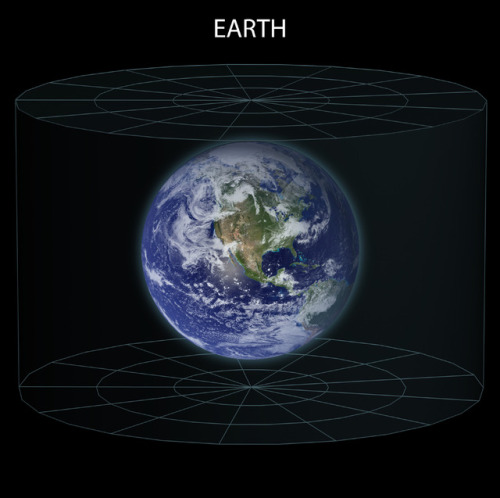
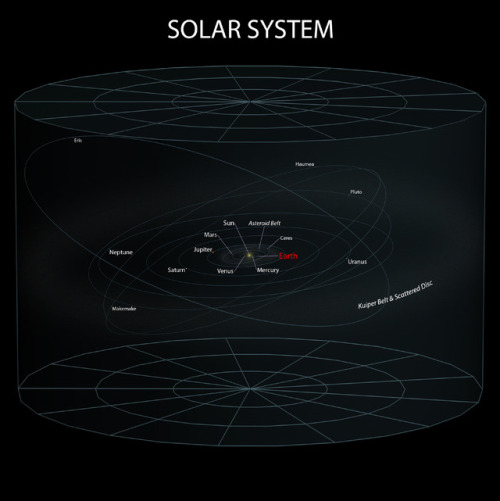
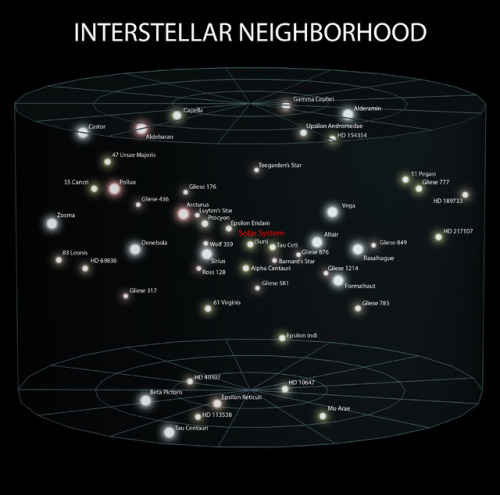
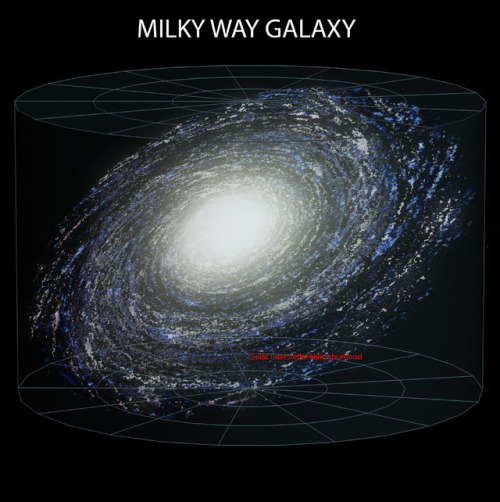
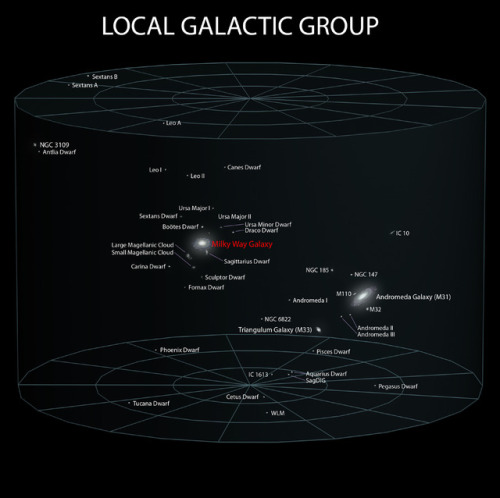
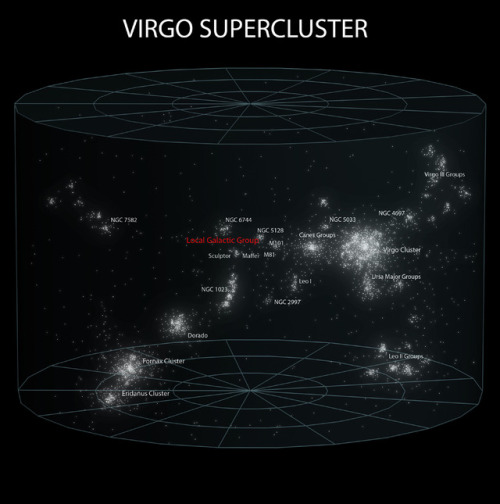
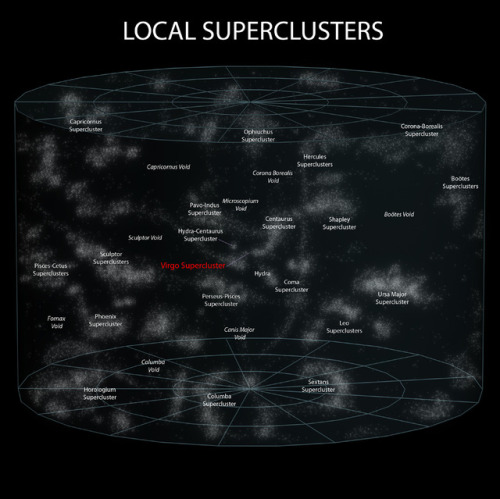
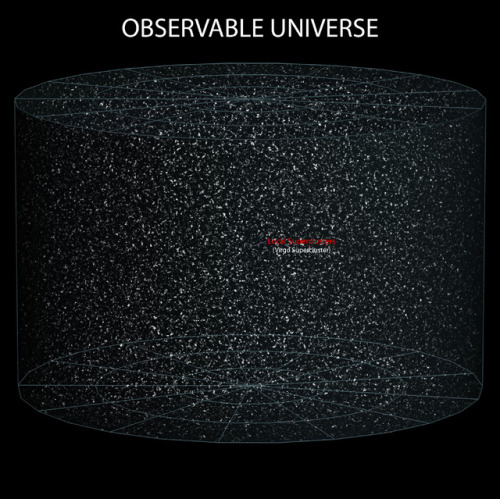
~ wikimedia commons

Merry Christmas! I spent time with my dear and sweet Kim. Let's go #furtherthanbefore with our #pathwaytothestars where get to explore solutions to worldwide issues, directing malcontent toward a refocus of their energies to #longevity and other sciences of #physics #biotechnology and #neuroscience through entertainment that takes us on a #scifi #fantasy journey with #strongfemaleleads #strongmalerolemodels and a beautiful #spaceopera with plenty of #politicalsciencefiction in the mix. (at Gene Leahy Mall) https://www.instagram.com/p/BrUuZFvgda1/?utm_source=ig_tumblr_share&igshid=s26phhseo3jb

Challenge and tragedy comes to everyone, it does not discriminate between good or bad... Our resolve to overcome these challenges and tragedies while maintaining our kindness and compassion, our dignity and grace, our vision to see a broader perspective and our strength of character to persevere are how we should measure ourselves... Only judge others based on the level of kindness they demonstrate, no matter what life brings, but be kind and love no matter the burden or reward... - 💜 -- Matt Opdyke
Interesting project. :)








How To Prove Einstein’s Relativity For Less Than $100
“But the fact that you can see cosmic ray muons at all is enough to prove that relativity is real. Think about where these muons are created: high in the upper atmosphere, about 30-to-100 kilometers above Earth’s surface. Think about how long a muon lives: about 2.2 microseconds on average. And think about the speed limit of the Universe: the speed of light, or about 300,000 kilometers per second. If you have something moving at the speed of light that only lives 2.2 microseconds, it should make it only 0.66 kilometers before decaying away. With that mean lifetime, less than 1-in-10^50 muons should reach the surface. But in reality, almost all of them make it down.”
Relativity, or the idea that space and time are not absolute, was one of the most revolutionary and counterintuitive scientific theories to come out of the 20th century. It was also one of the most disputed, with hundreds of scientists refusing to accept it. Yet with less than $100 and a single day’s worth of labor, there’s a way you can prove it to yourself: by building a cloud chamber. An old fishtank, some 100% ethyl or isopropyl alcohol, a metal base with dry ice beneath it and only a few other steps (see the full article for instructions) will allow you to construct a detector capable of seeing unstable cosmic particles. Yet these particles – and you’ll see about 1-per-second – would never reach Earth’s surface if it weren’t for relativity!
Come learn how you can validate Einstein’s first great revolution all for yourself, and silence the doubts in your mind. Nature really is this weird!
-
 trennorrcosngir liked this · 1 year ago
trennorrcosngir liked this · 1 year ago -
 forcepress42-blog liked this · 4 years ago
forcepress42-blog liked this · 4 years ago
